 As the Chancellor of the Exchequer, Philip Hammond, delivers his first Autumn statement, both the Office for Budget Responsibility (OBR) and the National Institute for Economic and Social Research (NIESR) have published updated forecasts for government borrowing and government debt.
As the Chancellor of the Exchequer, Philip Hammond, delivers his first Autumn statement, both the Office for Budget Responsibility (OBR) and the National Institute for Economic and Social Research (NIESR) have published updated forecasts for government borrowing and government debt.
They show a rise in government borrowing compared with previous forecasts. The main reason for this is a likely slowdown in the rate of economic growth and hence in tax revenues, especially in 2017. Last March, the OBR forecast GDP growth of 2.2% for 2017; it has now revised this down to 1.4%.
This forecast slowdown is because of a likely decline in the growth of aggregate demand caused by a decline in investment as businesses become more cautious given the uncertainty about the UK’s relationships with the rest of the world post Brexit. There is also likely to be a slowdown in real consumer expenditure as inflation rises following the fall in the pound of around 15%.
But what might be more surprising is that the public finances are not forecast to deteriorate even further. The OBR forecasts that the deficit will increase by a total of £122bn to £216bn over the period from 2016/17 to 2020/21. The NIESR predicts that it will rise by only £50bn to £187bn – but this is before the additional infrastructure spending and other measures announced in the Autumn Statement.
 One reason is looser monetary policy. Following the Brexit vote, the Bank of England cut Bank Rate from 0.5% to 0.25% and introduced further quantitative easing. This makes it cheaper to finance government borrowing. What is more, the additional holdings of bonds by the Bank mean that the Bank returns to the government much of the interest (coupon payments) that would otherwise have been paid to the private sector.
One reason is looser monetary policy. Following the Brexit vote, the Bank of England cut Bank Rate from 0.5% to 0.25% and introduced further quantitative easing. This makes it cheaper to finance government borrowing. What is more, the additional holdings of bonds by the Bank mean that the Bank returns to the government much of the interest (coupon payments) that would otherwise have been paid to the private sector.
Then, depending on the nature of the UK’s post-Brexit relationships with the EU, there could be savings in contributions to the EU budget – but just how much, no-one knows at this stage.
Finally, it depends on just what effects the measures announced in the Autumn Statement will have on tax revenues and government spending. We will examine this in a separate blog.
But even though public-sector borrowing is likely to fall more slowly than before the Brexit vote, the trajectory is still downward. Indeed, the previous Chancellor, George Osborne, had set a target of achieving a public-sector surplus by 2019/20.
But, would eventually bringing the public finances into surplus be desirable? Apart from the dampening effect on aggregate demand, such a policy could lead to underinvestment in infrastructure and other public-sector capital. There is thus a strong argument for continuing to run a deficit on the public-sector capital account to fund public-sector investment – such investment will increase incomes and social wellbeing in the future. It makes sense for the government to borrow for investment, just as it makes sense for the private sector to do so.
Articles
Autumn Statement: Why the damage to the public finances from Brexit might not be as bad as some think Independent, Simon Kirby (22/11/16)
Three Facts about Debt and Deficits NIESR blogs, R Farmer (21/11/16)
Autumn Statement: Big increase in borrowing predicted BBC News, Anthony Reuben (23/11/16)
Data
Economic and fiscal outlook – November 2016 Office for Budget Responsibility (23/11/16)
Questions
- Why have the public finances deteriorated?
- How much have they deteriorated?
- What is likely to happen to economic growth over the next couple of years? Explain why.
- How has the cut in Bank Rate and additional quantitative easing introduced after the Brexit vote affected government borrowing?
- What is likely to happen to (a) public-sector borrowing; (b) public-sector debt as a proportion of GDP over the next few years?
- Why is a running a Budget surplus neither a necessary nor a sufficient condition for reducing the government debt to GDP ratio.
- What are the arguments for (a) having a positive public-sector debt; (b) increasing public-sector debt as a result of increased spending on infrastructure and other forms of public-sector capital?

The first article below, from The Economist, examines likely macroeconomic policy under Donald Trump. He has stated that he plans to cut taxes, including reducing the top rates of income tax and reducing taxes on corporate income and capital gains. At the same time he has pledged to increase infrastructure spending.
This expansionary fiscal policy is unlikely to be accompanied by accommodating monetary policy. Interest rates would therefore rise to tackle the inflationary pressures from the fiscal policy. One effect of this would be to drive up the dollar and therein lies significant risks.
The first is that the value of dollar-denominated debt would rise in foreign currency terms, thereby making it difficult for countries with high levels of dollar debt to service those debts, possibly leading to default and resulting international instability. At the same time, a rising dollar may encourage capital 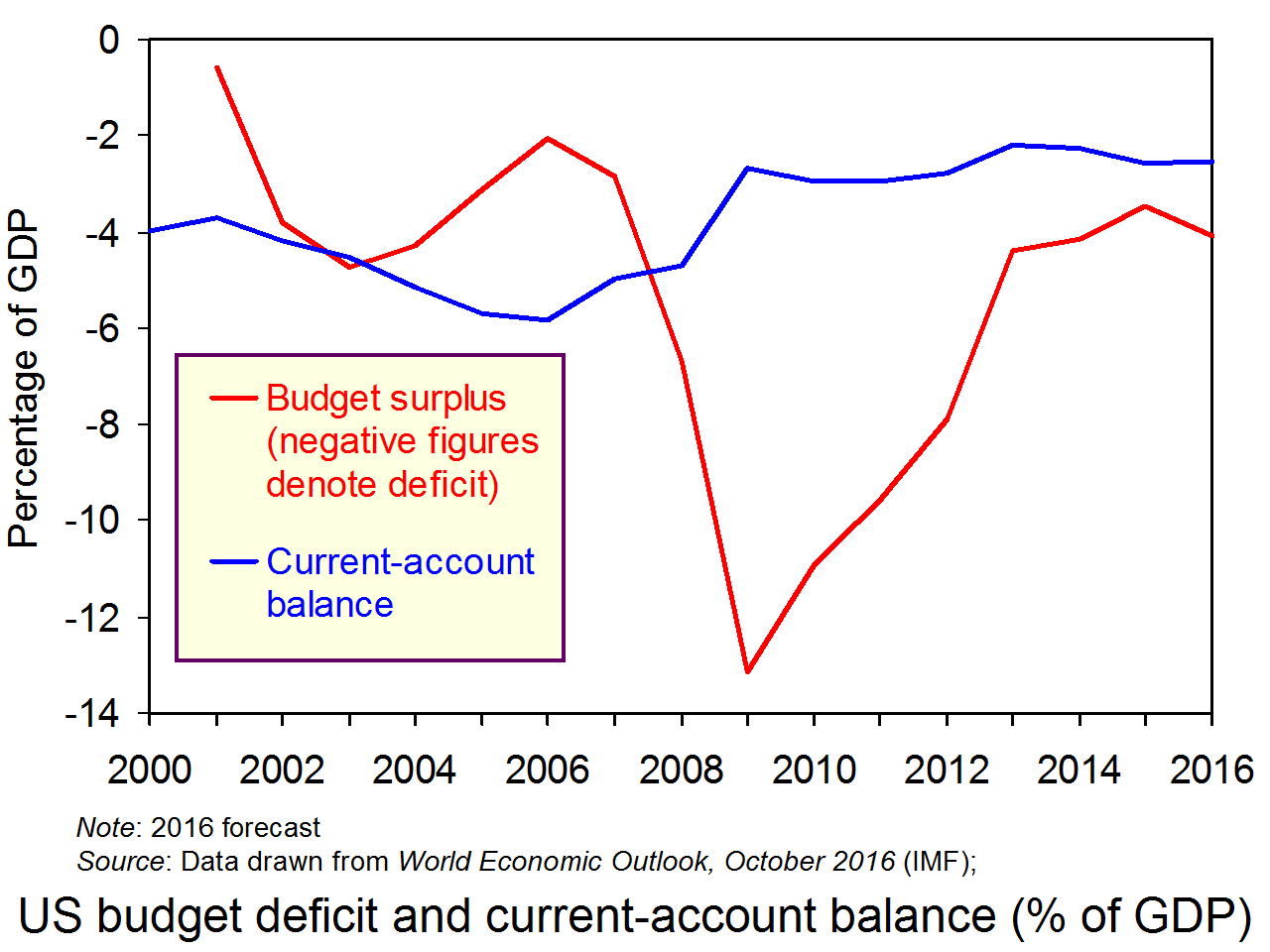 flight from weaker countries to the US (see The Economist article, ‘Emerging markets: Reversal of fortune’).
flight from weaker countries to the US (see The Economist article, ‘Emerging markets: Reversal of fortune’).
The second risk is that a rising dollar would worsen the US balance of trade account as US exports became less competitive and imports became more so. This may encourage Donald Trump to impose tariffs on various imports – something alluded to in campaign speeches. But, as we saw in the blog, Trump and Trade, “With complex modern supply chains, many products use components and services, such as design and logistics, from many different countries. Imposing restrictions on imports may lead to damage to products which are seen as US products”.
The third risk is that the main beneficiaries of Trump’s likely fiscal measures will be the rich, who would end up paying significantly less tax. With all the concerns from poor Americans, including people who voted for Trump, about growing inequality, measures that increase this inequality are unlikely to prove popular.
Articles
That Eighties show The Economist, Free Exchange (19/11/16)
The unbearable lightness of a stronger dollar Financial Times (18/11/16)
Questions
- What should the Fed’s response be to an expansionary fiscal policy?
- Which is likely to have the larger multiplier effect: (a) tax revenue reductions from cuts in the top rates of income; (b) increased government spending on infrastructure projects? Explain your answer.
- Could Donald Trump’s proposed fiscal policy lead to crowding out? Explain.
- What would protectionist policies do to (a) the US current account and (b) dollar exchange rates?
- Why might trying to protect US industries from imports prove difficult?
- Why might Trump’s proposed fiscal policy lead to capital flight from certain developing countries? Which types of country are most likely to lose from this process?
- Go though each of the three risks referred to in The Economist article and identify things that the US administration could do to mitigate these risks.
- Why may the rise in the US currency since the election be reversed?
 We have frequently looked at patterns in lending by financial institutions in our blogs given that many economies, like the UK, display cycles in credit. Central banks now pay considerable attention to the possibility of such cycles destabilising economies and causing financial distress to people and businesses. There is also increased interest here in the UK in bank lending data in light of Brexit. Patterns in credit flows may indicate whether it is affecting the lending choices of financial institutions and borrowing choices of people and businesses.
We have frequently looked at patterns in lending by financial institutions in our blogs given that many economies, like the UK, display cycles in credit. Central banks now pay considerable attention to the possibility of such cycles destabilising economies and causing financial distress to people and businesses. There is also increased interest here in the UK in bank lending data in light of Brexit. Patterns in credit flows may indicate whether it is affecting the lending choices of financial institutions and borrowing choices of people and businesses.
Data from the Bank of England’s Money and Credit – September 2016 statistical release shows net lending (lending net of repayments) by monetary financial institutions (MFIs) to individuals in September 2016 was £4.65 billion. This compares with £8.89 billion back in March 2016 which then was the highest monthly total since August 2007. However, the March figure was something of a spike in lending and this September’s figure is actually very slightly above the monthly average over the last 12 months, excluding March, of £4.5 billion. In other words, as yet, there is no discernible change in the pattern of credit flows post-Brexit.
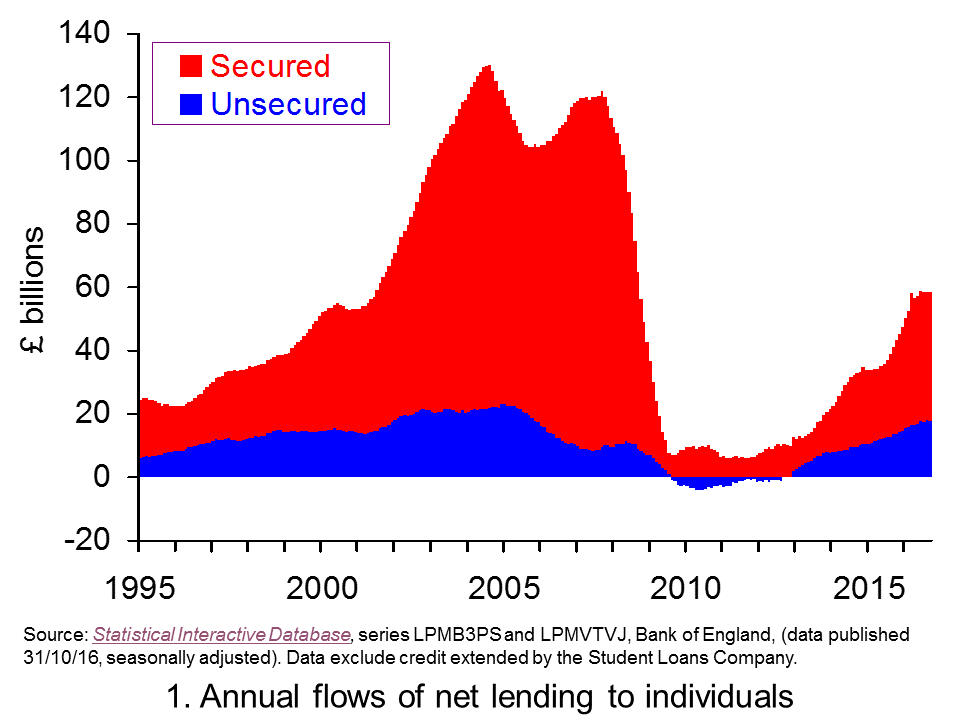 Leaving aside the question of the economic impact of Brexit, we still need to consider what the credit data mean for financial stability and for our financial well-being. Chart 1 shows the annual flows of lending by banks and building societies since the mid 1990s. The chart evidences the cycles in secured lending and in consumer credit (unsecured lending) with its consequent implications for economic and financial-welling being.(Click here to download a PowerPoint of Chart 1.)
Leaving aside the question of the economic impact of Brexit, we still need to consider what the credit data mean for financial stability and for our financial well-being. Chart 1 shows the annual flows of lending by banks and building societies since the mid 1990s. The chart evidences the cycles in secured lending and in consumer credit (unsecured lending) with its consequent implications for economic and financial-welling being.(Click here to download a PowerPoint of Chart 1.)

After the financial crisis, as Chart 1 shows, net lending to individuals collapsed. More recently, net lending has been on the rise both through secured lending and in consumer credit. The latest data show that annual flows have begun to plateau. Nonetheless, the total flow of credit in the 12 months to September of £58 billion compares with £33 billion and £41 billion in the 12 months to September 2014 and 2015 respectively. Having said this, in the 12 months to September 2007 the figure was £112 billion! £58 billion is currently equivalent to around about 3 per cent of GDP.
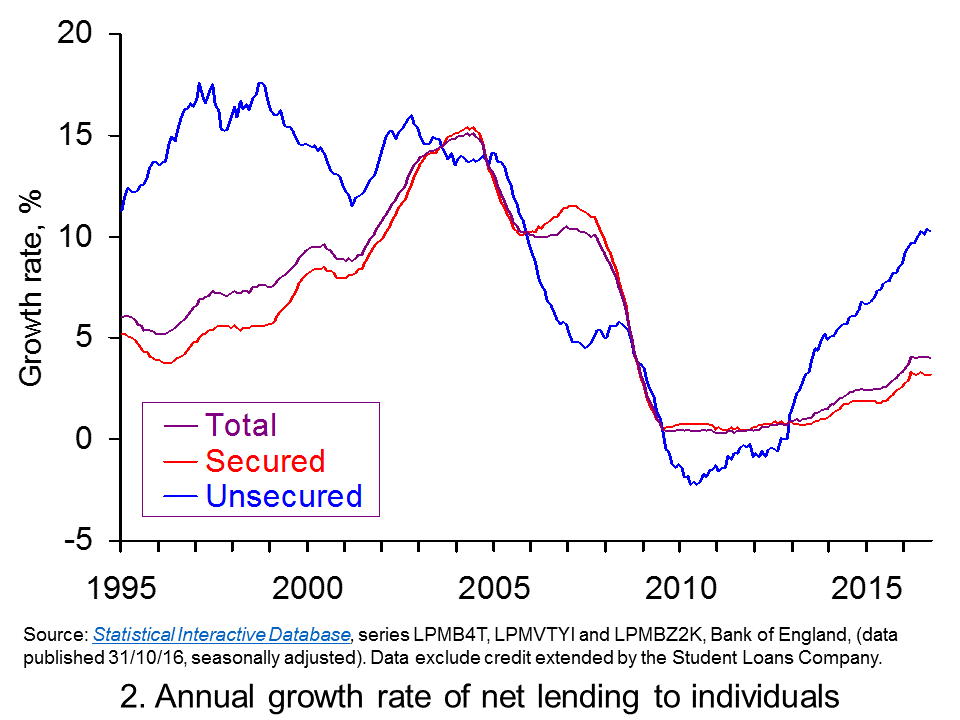 To more readily see the effect of the credit flows on debts stocks, Chart 2 shows the annual growth rate of net lending by MFIs. In essence, this mirrors the growth rate in the stocks of debt which is an important metric of financial well-being. The chart nicely captures the pick up in the growth of lending from around the start of 2013. What is particularly noticeable is the very strong rates of growth in net unsecured lending from MFIs. The growth of unsecured lending remains above 10 per cent, comparable with rates in the mid 2000s. (Click here to download a PowerPoint of Chart 2.)
To more readily see the effect of the credit flows on debts stocks, Chart 2 shows the annual growth rate of net lending by MFIs. In essence, this mirrors the growth rate in the stocks of debt which is an important metric of financial well-being. The chart nicely captures the pick up in the growth of lending from around the start of 2013. What is particularly noticeable is the very strong rates of growth in net unsecured lending from MFIs. The growth of unsecured lending remains above 10 per cent, comparable with rates in the mid 2000s. (Click here to download a PowerPoint of Chart 2.)
The growth in debt stocks arising from lending continues to demonstrate the need for individuals to be mindful of their financial well-being. This caution is perhaps more important given the current economics uncertainties. The role of the Financial Policy Committee in the UK is to monitor the financial well-being of economic agents in the context of ensuring the resilience of the financial system. It therefore analyses the data on credit flows and debt stocks referred to in this blog along with other relevant metrics. At this moment its stance is not to apply any additional buffer – known as the Countercyclical Capital Buffer – on a financial institution’s exposures in the UK over and above internationally agreed standards. Regardless, the fact that it explicitly monitors financial well-being and risk shows just how significant the relationship between the financial system and economic outcomes is now regarded.
Articles
Higher inflation and rising debt threaten millions in UK The Guardian, Angela Monaghan (5/11/16)
Consumer spending has saved the economy in the past – but we cannot bet on it forever Sunday Express, Geff Ho (13/11/16)
Warning as household debts rise to top £1.5 trillion BBC News, Hannah Richardson (7/11/16)
Household debt hits record high – How to get back on track if you’re in the red Mirror, Graham Hiscott (7/12/16)
Data
Money and Credit – September 2016 Bank of England
Bankstats (Monetary and Financial Statistics) – Latest Tables Bank of England
Statistical Interactive Database Bank of England
Questions
- Explain the difference between secured debt and unsecured debt.
- What does it mean if individuals are financially distressed?
- How would we measure the financial well-being of individuals and households?
- What actions might individuals take it they are financially distressed? What might the economic consequences be?
- How might uncertainty, such as that following the UK vote to leave the European Union, affect spending and savings’ decisions by households?
- What measures can institutions, like the UK’s Financial Policy Committee, take to reduce the likelihood that flows of credit become too excessive?
 The article below looks at the economy of Brazil. The statistics do not look good. Real output fell last year by 3.8% and this year it is expected to fall by another 3.3%. Inflation this year is expected to be 9.0% and unemployment 11.2%, with the government deficit expected to be 10.4% of GDP.
The article below looks at the economy of Brazil. The statistics do not look good. Real output fell last year by 3.8% and this year it is expected to fall by another 3.3%. Inflation this year is expected to be 9.0% and unemployment 11.2%, with the government deficit expected to be 10.4% of GDP.
The article considers Keynesian economics in the light of the case of Brazil, which is suffering from declining potential supply, but excess demand. It compares Brazil with the case of most developed countries in the aftermath of the financial crisis. Here countries have suffered from a lack of demand, made worse by austerity policies, and only helped by expansionary monetary policy. But the effect of the monetary policy has generally been weak, as much of the extra money has been  used to purchase assets rather than funding a growth in aggregate demand.
used to purchase assets rather than funding a growth in aggregate demand.
Different policy prescriptions are proposed in the article. For developed countries struggling to grow, the solution would seem to be expansionary fiscal policy, made easy to fund by lower interest rates. For Brazil, by contrast, the solution proposed is one of austerity. Fiscal policy should be tightened. As the article states:
Spending restraint might well prove painful for some members of Brazilian society. But hyperinflation and default are hardly a walk in the park for those struggling to get by. Generally speaking, austerity has been a misguided policy approach in recent years. But Brazil is a special case. For now, anyway.
The tight fiscal policies could be accompanied by supply-side policies aimed at reducing bureaucracy and inefficiency.
Article
Brazil and the new old normal: There is more than one kind of economic mess to be in The Economist, Free Exchange Economics (12/10/16)
Questions
- Explain what is meant by ‘crowding out’.
- What is meant by the ‘liquidity trap’? Why are many countries in the developed world currently in a liquidity trap?
- Why have central banks in the developed world found it difficult to stimulate growth with policies of quantitative easing?
- Under what circumstances would austerity policies be valuable in the developed world?
- Why is crowding out of fiscal policy unlikely to occur to any great extent in Europe, but is highly likely to occur in Brazil?
- What has happened to potential GDP in Brazil in the past couple of years?
- What is meant by the ‘terms of trade’? Why have Brazil’s terms of trade deteriorated?
- What sort of policies could the Brazilian government pursue to raise growth rates? Are these demand-side or supply-side policies?
- Should Brazil pursue austerity policies and, if so, what form should they take?
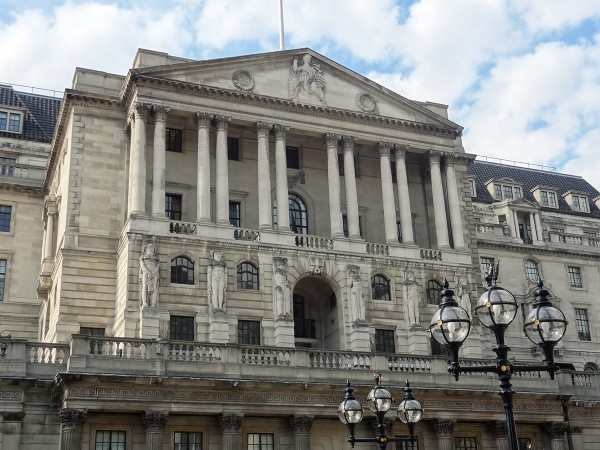 The Bank of England’s monetary policy is aimed at achieving an inflation rate of 2% CPI inflation ‘within a reasonable time period’, typically within 24 months. But speaking in Nottingham in one of the ‘Future Forum‘ events on 14 October, the Bank’s Governor, Mark Carney, said that the Bank would be willing to accept inflation above the target in order to protect growth in the economy.
The Bank of England’s monetary policy is aimed at achieving an inflation rate of 2% CPI inflation ‘within a reasonable time period’, typically within 24 months. But speaking in Nottingham in one of the ‘Future Forum‘ events on 14 October, the Bank’s Governor, Mark Carney, said that the Bank would be willing to accept inflation above the target in order to protect growth in the economy.
“We’re willing to tolerate a bit of an overshoot in inflation over the course of the next few years in order to avoid rising unemployment, to cushion the blow and make sure the economy can adjust as well as possible.”
But why should the Bank be willing to relax its target – a target set by the government? In practice, a temporary rise above 2% can still be consistent with the target if inflation is predicted to return to 2% within ‘a reasonable time period’.
 But if even if the forecast rate of inflation were above 2% in two years’ time, there would still be some logic in the Bank not tightening monetary policy – by raising Bank Rate or ending, or even reversing, quantitative easing. This would be the case when there was, or forecast to be, stagflation, whether actual or as a result of monetary policy.
But if even if the forecast rate of inflation were above 2% in two years’ time, there would still be some logic in the Bank not tightening monetary policy – by raising Bank Rate or ending, or even reversing, quantitative easing. This would be the case when there was, or forecast to be, stagflation, whether actual or as a result of monetary policy.
The aim of an inflation target of 2% is to help create a growth in aggregate demand consistent with the economy operating with a zero output gap: i.e. with no excess or deficient demand. But when inflation is caused by rising costs, such as that caused by a depreciation in the exchange rate, inflation could still rise even though the output gap were negative.
A rise in interest rates in these circumstances could cause the negative output gap to widen. The economy could slip into stagflation: rising prices and falling output. Hopefully, if the exchange rate stopped falling, inflation would fall back once the effects of the lower exchange rate had fed through. But that might take longer than 24 months or a ‘reasonable period of time’.
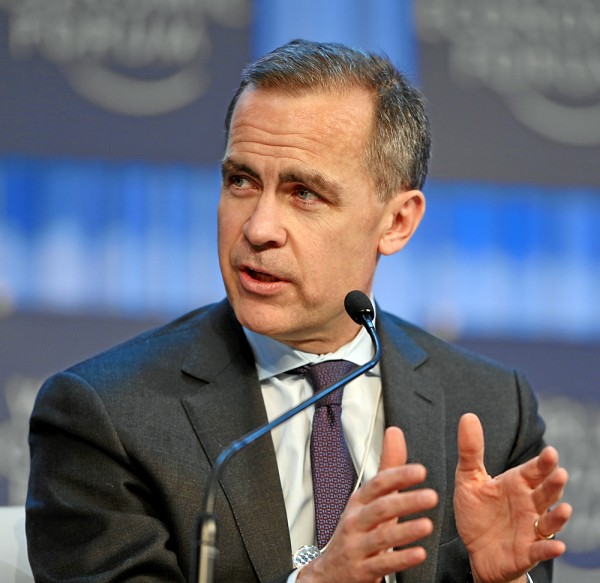 So even if not raising interest rates in a situation of stagflation where the inflation rate is forecast to be above 2% in 24 months’ time is not in the ‘letter’ of the policy, it is within the ‘spirit’.
So even if not raising interest rates in a situation of stagflation where the inflation rate is forecast to be above 2% in 24 months’ time is not in the ‘letter’ of the policy, it is within the ‘spirit’.
But what of exchange rates? Mark Carney also said that “Our job is not to target the exchange rate, our job is to target inflation. But that doesn’t mean we’re indifferent to the level of sterling. It does matter, ultimately, for inflation and over the course of two to three years out. So it matters to the conduct of monetary policy.”
But not tightening monetary policy if inflation is forecast to go above 2% could cause the exchange rate to fall further. It seems as if trying to arrest the fall in sterling and prevent a fall into recession are conflicting aims when the policy instrument for both is the rate of interest.
Articles
BoE’s Carney says not indifferent to sterling level, boosts pound Reuters, Andy Bruce and Peter Hobson (14/10/16)
Bank governor Mark Carney says inflation will rise BBC News, Kamal Ahmed (14/10/16)
Stagflation Risk May Mean Carney Has Little Love for Marmite Bloomberg, Simon Kennedy (14/10/16)
Bank can ‘let inflation go a bit’ to protect economy from Brexit, says Carney – but sterling will be a factor for interest rates This is Money, Adrian Lowery (14/10/16)
UK gilt yields soar on ‘hard Brexit’ and inflation fears Financial Times, Michael Mackenzie and Mehreen Khan (14/10/16)
Brexit latest: Life will ‘get difficult’ for the poor due to inflation says Mark Carney Independent, Ben Chu (14/10/16)
Prices to continue rising, warns Bank of England governor The Guardian, Katie Allen (14/10/16)
Bank of England
Monetary Policy Bank of England
Monetary Policy Framework Bank of England
How does monetary policy work? Bank of England
Future Forum 2016 Bank of England
Questions
- Explain the difference between cost-push and demand-pull inflation.
- If inflation rises as a result of rising costs, what can we say about the rate of increase in these costs? Is it likely that cost-push inflation would persist beyond the effects of a supply-side shock working through the economy?
- Can interest rates be used to control both inflation and the exchange rate? Explain why or why not.
- What is the possible role of fiscal policy in the current situation of a falling exchange rate and rising inflation?
- Why does the Bank of England target the rate of inflation in 24 months’ time and not the rate today? (After all, the Governor has to write a letter to the Chancellor explaining why inflation in any month is more than 1 percentage point above or below the target of 2%.)
- What is meant by a zero output gap? Is this the same as a situation of (a) full employment, (b) operating at full capacity? Explain.
- Why have UK gilt yields soared in the light of a possible ‘hard Brexit’, a falling exchange rate and rising inflation?
 As the Chancellor of the Exchequer, Philip Hammond, delivers his first Autumn statement, both the Office for Budget Responsibility (OBR) and the National Institute for Economic and Social Research (NIESR) have published updated forecasts for government borrowing and government debt.
As the Chancellor of the Exchequer, Philip Hammond, delivers his first Autumn statement, both the Office for Budget Responsibility (OBR) and the National Institute for Economic and Social Research (NIESR) have published updated forecasts for government borrowing and government debt. One reason is looser monetary policy. Following the Brexit vote, the Bank of England cut Bank Rate from 0.5% to 0.25% and introduced further quantitative easing. This makes it cheaper to finance government borrowing. What is more, the additional holdings of bonds by the Bank mean that the Bank returns to the government much of the interest (coupon payments) that would otherwise have been paid to the private sector.
One reason is looser monetary policy. Following the Brexit vote, the Bank of England cut Bank Rate from 0.5% to 0.25% and introduced further quantitative easing. This makes it cheaper to finance government borrowing. What is more, the additional holdings of bonds by the Bank mean that the Bank returns to the government much of the interest (coupon payments) that would otherwise have been paid to the private sector.








